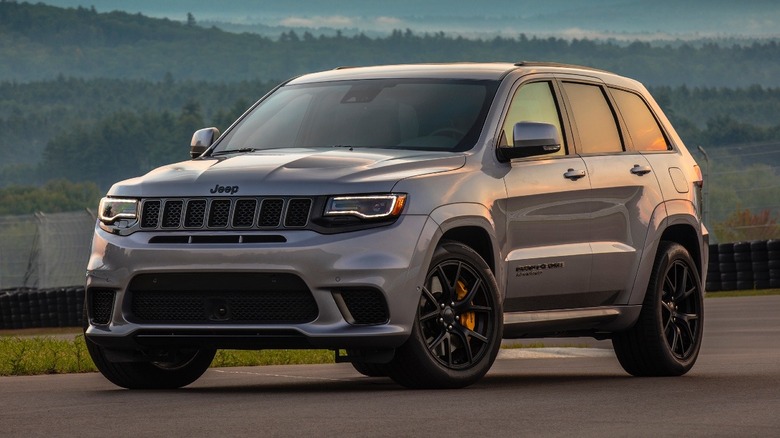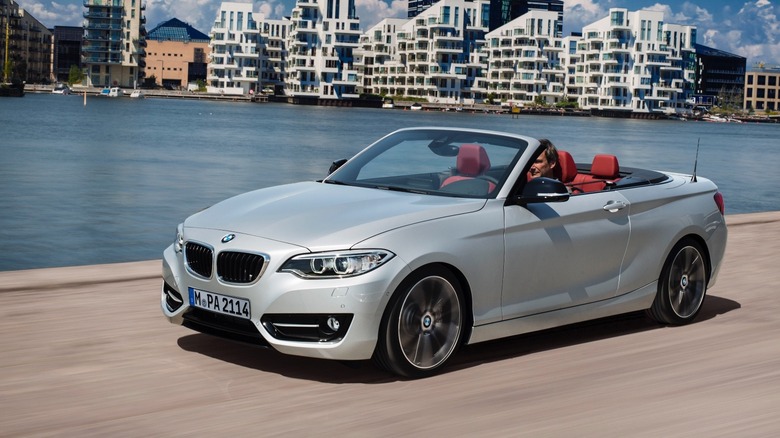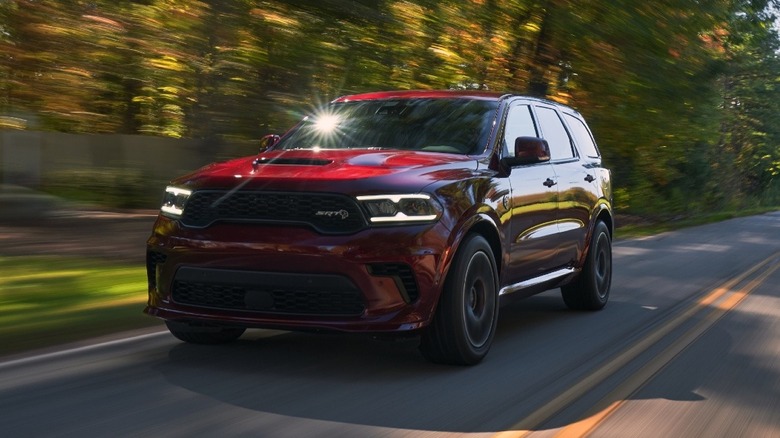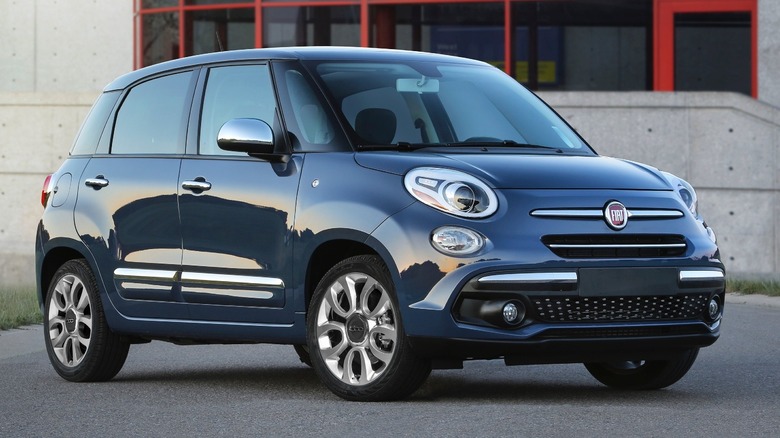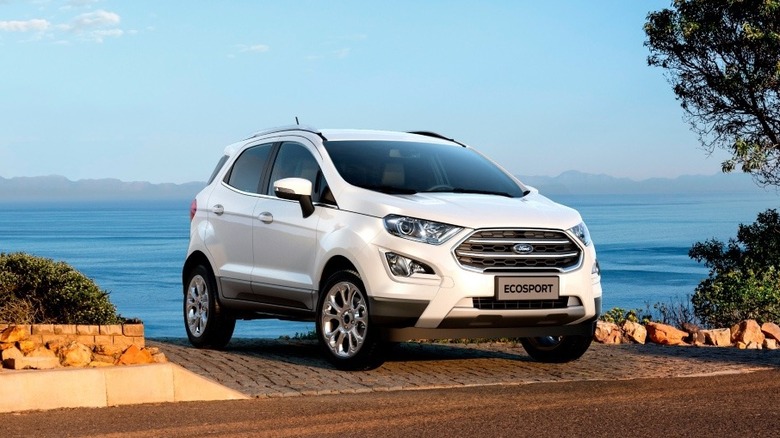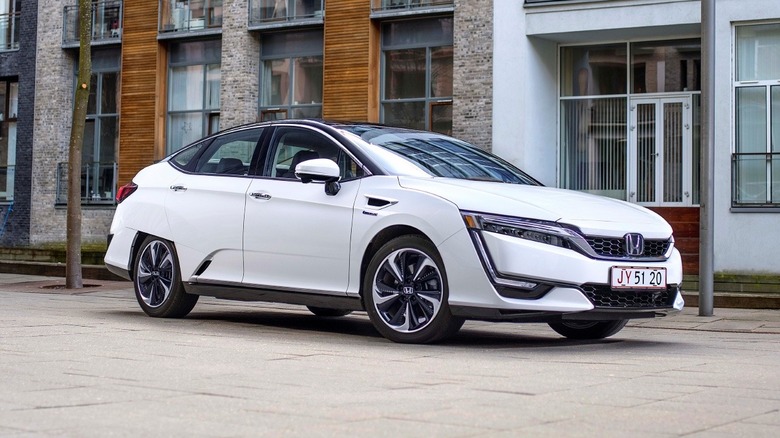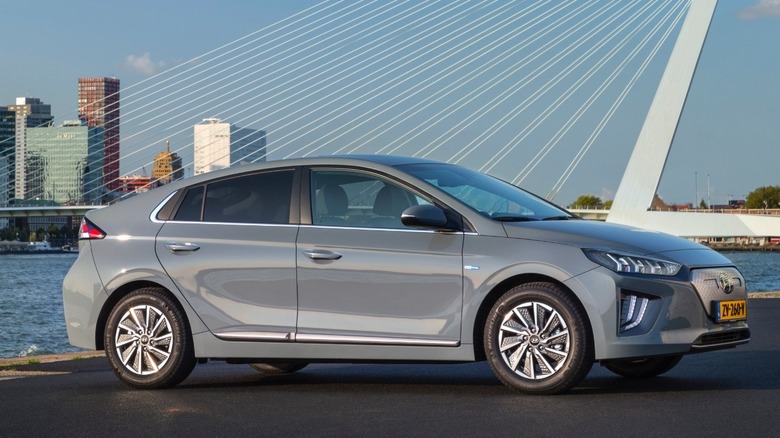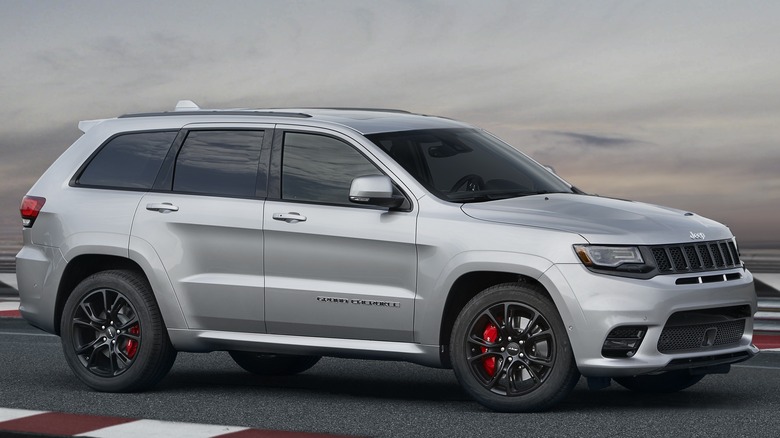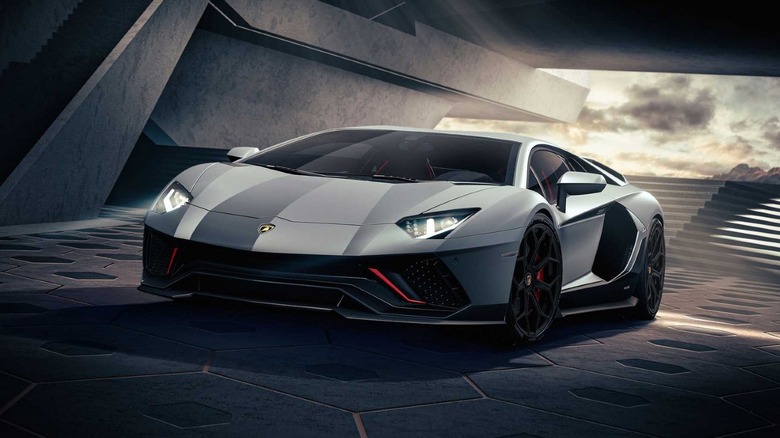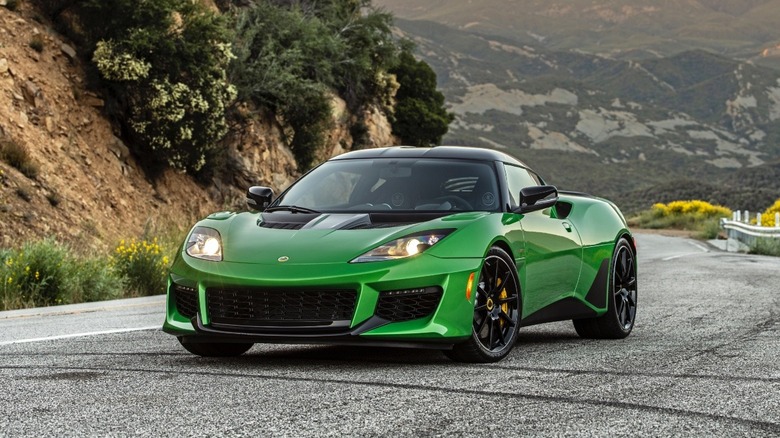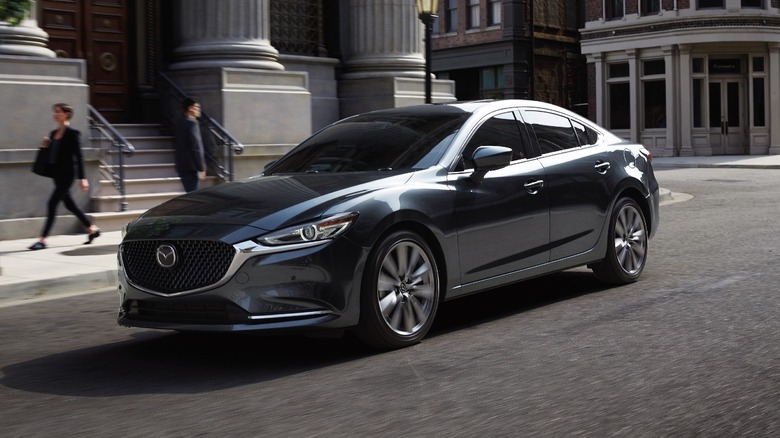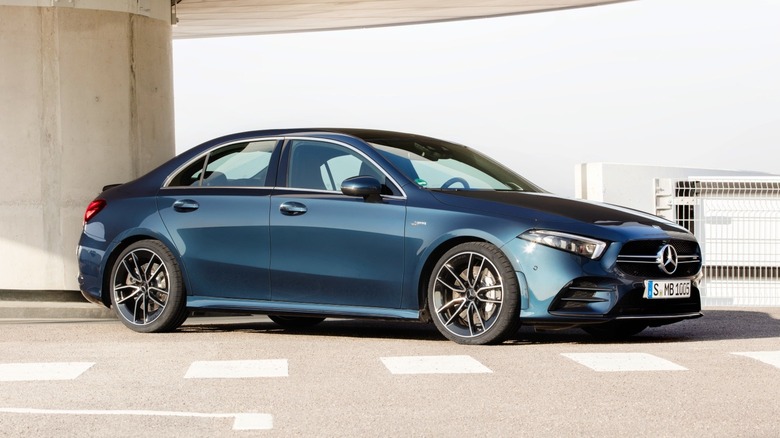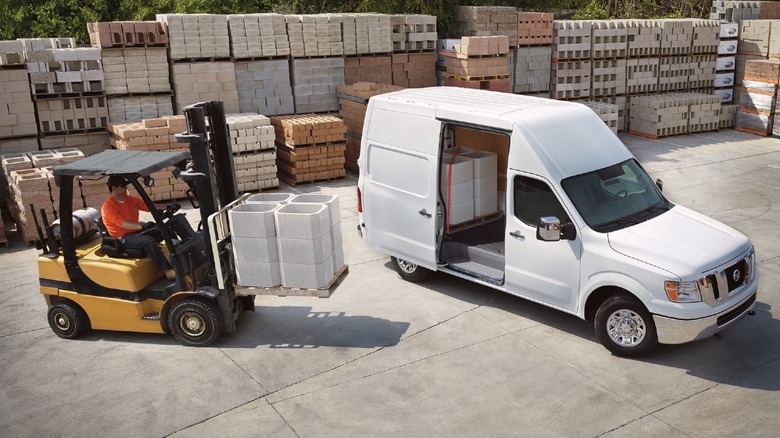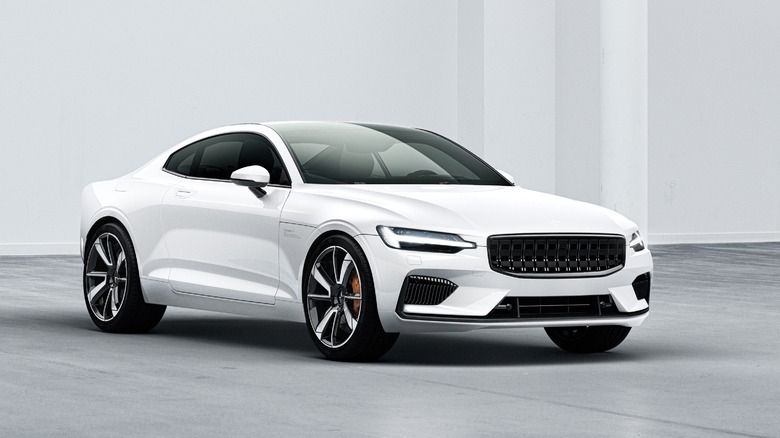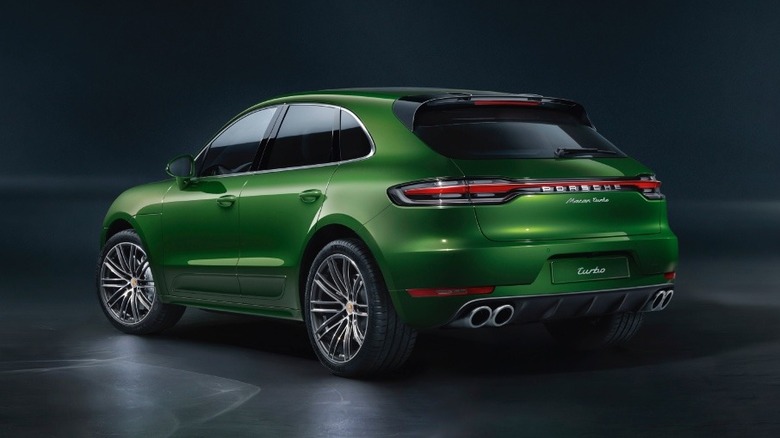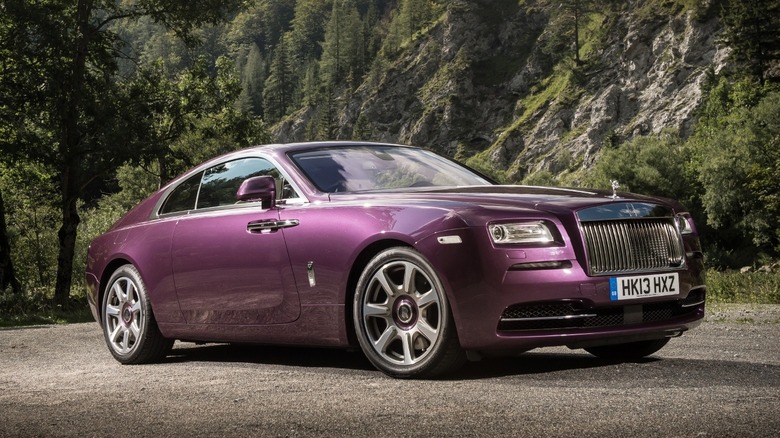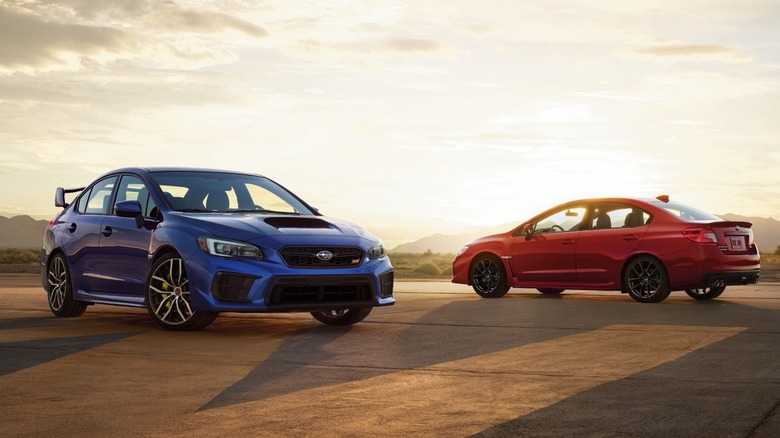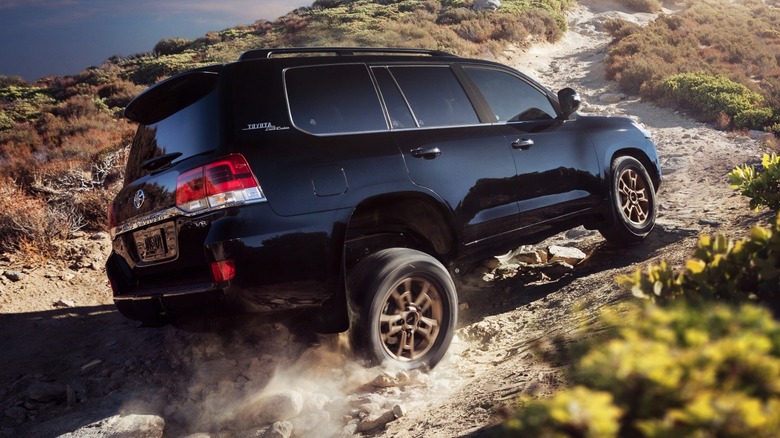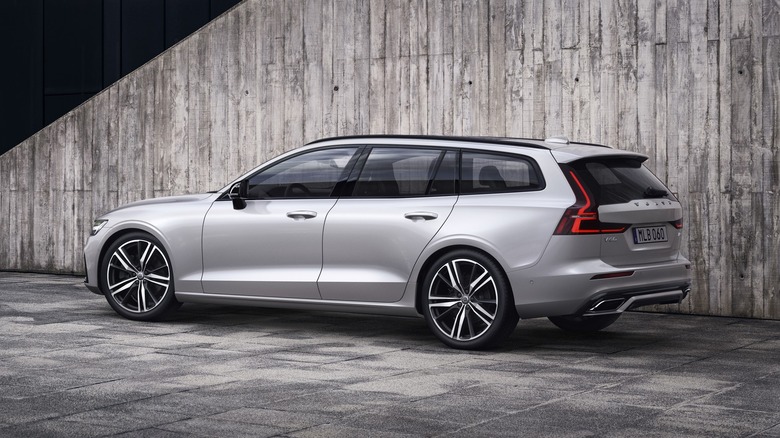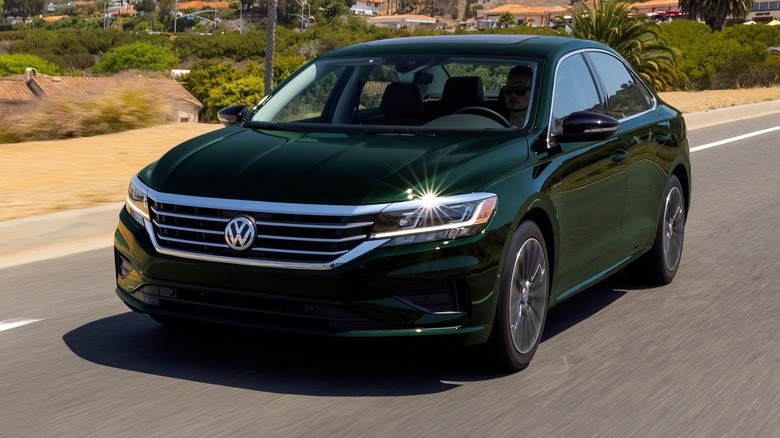Every Car That Was Discontinued In 2022
The push toward electrification has, without doubt, put a lot of pressure on the U.S auto industry. With the trend progressing in full force, it's inevitable that carmakers restructure their lineup, accommodating new models as some of the old ones bid farewell to the United States.
The motive, as per manufacturers, is part monetary and part strategic. Reasons range from poor sales volumes to internal competition to becoming entirely outdated and losing popularity. Survival of the fittest, as our list of all vehicles axed for 2022 makes clear. Roughly 30 names are on the roster, some of which have been serving in the United States for over 20 years. From icons like the WRX STI and Land Cruiser, to exotics like the Lamborghini Aventador and Rolls-Royce Wraith, the list is populated with cars from all genres, including cargo vans and fuel-cell vehicles.
Without further ado, here's the list of every car that's been discontinued for the 2022 model year.
BMW
2022 has been a great year for BMW so far. Unveils like the sporty M4 CSL, the tech-filled 7-series, and the color-changing iX have all been a step in the right direction. However, 2022 is also witnessing the demise of three fairly popular models from the Bavarian marque (via Motor1). The i3 is bidding farewell; BMW has officially discontinued the model. Sure, its funky and futuristic interior offered a refreshing change, but poor EV range (153 miles) and steep price tag made rivals like the Hyundai Kona Electric and Kia Niro EV look extremely attractive.
Also discontinued for 2022 are the F87-gen M2 sports coupe and the 2-series convertible (F22 generation). Fortunately, they're not leaving for good. Since the 2-series has just received a complete overhaul, it's only a matter of time before BMW unveils the G42 generation 2-series convertible and a successor to the F87 M2. Safe to say, both nameplates are just a 2022 omission.
Dodge
The Durango SRT Hellcat serves a niche, which in times like these may not entirely make sense. Dodge has the Charger and Challenger Hellcats, which, although have their days numbered, are two gas-guzzling items in production, emitting hefty CO2 numbers. Since automakers are now given net emissions targets, Dodge, which has a fleet of high-performance gasoline vehicles, is hardly going to meet them if it keeps selling cars like the Durango Hellcat. So it's obvious why Dodge decided to axe this ludicrously fast seven-seater for the 2022 model year.
Having 8,700 pounds of towing capacity and plenty of passenger room makes it an excellent competitor in the three-row SUV space. However, delivering 13 mpg won't do it any good in today's tightly regulated conditions, and the fumes belching out of a 710-horsepower supercharged V8 SUV aren't helping either. Ironically, though it may be taking a bow this year, Dodge is still bringing back the Durango Hellcat for the 2023 model year, citing popular demand.
Fiat
This may not come as a surprise, since Fiat's sales in the United States have been rather poor. Per Motor1, Fiat only managed to shift just 475 of these 500Ls in 2020. It wasn't a particularly successful item in the Fiat roster. Even in its prime, Fiat only managed to sell 12,000 units of the 500L per year, which isn't something you'd call a grand success. And the reason is pretty simple.
The 500L is utterly a chore to drive, has some of the worst and cheap-looking interiors, and accelerates like an old-fashioned 20th-century item. At least, that's what Car and Driver had to say. Adding insult to injury, the Fiat 500L, despite being a near-$27,000 prospect, has no form of driver assistance tech available. You don't get auto-emergency braking, blind-spot monitoring, or adaptive cruise control. What Fiat offers you are a backup camera and rear parking sensors. No wonder sales tanked, forcing the Italian carmaker to axe the model in the U.S.
Ford
Discontinuing the EcoSport is the perfect example of avoiding internal competition. The Bronco Sport is newer, as is the Ford Maverick pickup. The latter is even cheaper than the EcoSport, too, so it's only logical that buyers gravitate toward the latest and greatest. Particularly amid EcoSport complaints including sub-par interiors to poor drive quality.
Competitors like the Mazda CX-30 and Hyundai Kona offer far better value. That said, the EcoSport offers standard all-wheel-drive and a 2,000-pound tow rating, which is respectable for a sub-compact SUV. Maneuverability is an added bonus, as is the elevated driving position. Otherwise, the Maverick's better interiors, efficient engines, and increased practicality make it far more attractive in Ford's lineup. As is the case with the Bronco Sport.
If sales figures are considered, Ford managed to shift just 40,000 EcoSports in 2021, while Hyundai sold nearly 90,000 Konas in the same year. The EcoSport's demise is further accelerated by Ford's withdrawal from India, winding up all vehicle production, including that of the EcoSport, which is manufactured in India.
Honda
Honda is not a name you usually hear when it comes to discontinuing models. However, this one is rather an oddball. The car in question is the Clarity. Honda already killed off the Clarity's all-electric counterpart in 2020 and has gone ahead with discontinuing the fuel-cell and PHEV models. Even though Honda managed to sell nearly 12,000 units in 2019, sales across 2020 and 2021 weren't all that exciting. Why no demand? Well, it has to do with not-so-competitive pricing, limited availability of hydrogen, and overall range (approximately 48 miles in the PHEV).
Per Honda, the decision to axe the model is mostly to diversify its upcoming electric lineup. Whether the Clarity nameplate will return is unsure, but Honda is planning to introduce several electric and hydrogen-powered vehicles over the next two decades. Honda says it will only sell battery-electric and hydrogen vehicles by 2040, so an updated version of the Clarity cannot be ruled out. However, nothing's official as of yet.
Hyundai
It's no surprise why Hyundai's discontinuing the Ioniq Electric. The Korean marque already has the 258-mile Kona Electric and the widely acclaimed Ioniq 5, offering 303 miles of EV range, in its portfolio. What place, then, for the Ioniq Electric, with its rather paltry 170-mile range? That said, while the Electric model is discontinued, the Ioniq PHEV and hybrid models will continue for the 2022 model year.
Another model getting discontinued is the Hyundai Veloster. Yet another compact offering bids farewell to the United States. The decision is purely based on market demand: Hyundai managed to sell over 28,000 units of the Venue subcompact, while less than 2,000 units of the Veloster were sold in 2021. However, not all Veloster models are discontinued for 2022. Hyundai's spicy little Veloster N hatchback will stick around for one more year. The hot hatch was the N performance division's first offering in the United States, followed by the Elantra N sports sedan and the Kona N crossover.
Jeep
Just like the Dodge Durango SRT Hellcat, the Grand Cherokee SRT and Trackhawk will not carry over to the 2022 model year. The Jeep Grand Cherokee Trackhawk remains one of the fastest modern SUVs for the money. Beneath your right foot is 707 horsepower from a 6.2-liter supercharged Hellcat V8. Torque figures are an astounding 645 lb-ft. The Grand Cherokee SRT, on the other hand, features a 6.4L Hemi V8 pumping out 475 horsepower and 470 lb-ft of torque. Both machines can tow up to 7,200 lbs, numbers befitting proper utilitarians.
Moreover, the Trackhawk can reach 60 mph in 3.4 seconds, while the SRT is just a second slower—mighty impressive for SUVs weighing over 5,000 pounds. Alas, we can all blame stricter emissions regulations for the SRT twins' demise. The current Jeep Grand Cherokee trim lineup consists of Laredo, Altitude, Limited, Trailhawk, Overland, Summit, and Summit reserve. We reckon the Trackhawk could make a comeback sometime next year. However, instead of a raucous supercharged V8, it could feature a new turbocharged six-cylinder with some form of hybrid assistance.
Lamborghini
Lamborgini's flagship V12 will see its production end in 2022. The Lamborghini Aventador is nothing short of a masterpiece. Several iterations have been introduced, all of which feature a 6.5-liter naturally aspirated (NA) V12 in various states of tune. In typical Lambo fashion, we should expect its successor fairly soon—2023 seems very likely, per Carwow. The only Aventador on sale this year was the limited-run Ultimae, sold as the last hurrah for the NA V12.
All this indicates that 2022 is most certainly the Aventador's final model year, marking the end of Lamborghini's naturally aspirated V12 saga. However, the V12 engine is not exactly going away. Per Motor1, the Aventador's successor will feature the iconic engine with some form of hybrid assistance, much like the Sian hypercar. According to CEO Stephan Winkelmann, the V12 will feature a completely new design. Although, it could simply be a revised version of the existing powerplant, albeit with slightly more power. Nothing's certain at this point, but we're still excited.
Lotus
Lotus was never a hot-selling item in the United States, with limited brand awareness a lingering issue. With the new Emira revealed, Lotus is strategically removing its only series-production car from the U.S roster, the Lotus Evora GT. This fun little sports car, although rarer than its rivals, is a fantastic combination of handling and driving pleasure. You are offered a Toyota-sourced 3.5L supercharged V6 putting out 416 horsepower, with the option of a 6-speed manual or automatic transmission. Furthermore, well-engineered chassis dynamics help the car deliver a truly engaging driving experience.
But not everything about the sports car is great. The interior isn't the best, nor is the infotainment. But more importantly, the Evora GT was quite pricey for a sports coupe (via Car and Driver). Rivals like the Porsche 718 Boxster and Cayman offered far more value than the British thoroughbred. But with the Emira, things look promising. It's a gigantic leap from Lotus cars of the past and looks set to propel the British marque to new heights.
Mazda
Two Mazda models are dropped for the 2022 model year—the Mazda 6 sedan and the Mazda CX-3 subcompact SUV. The Mazda 6 is still a great car but, just like many sedans, the SUV onslaught is to be attributed for its demise. Technically speaking, the Mazda 6 is highly rated in its segment, besting all its competitors in terms of driving experience and interior ambiance. Car and Driver reports the Mazda 6 delivering a more expensive-feeling experience than the Honda Accord and the Hyundai Sonata, helping it win their Editors' Choice Award.
The CX-3 was in a fairly difficult spot after the arrival of the CX-30. Having the Mazda 3 hatchback and the newly-revealed CX-30 meant the CX-3 subcompact had to leave. While they're in the same segment, the Mazda CX-30 is noticeably larger than the CX-3. The CX-30 is also more powerful and costs about the same.
Mercedes-Benz
Mercedes-Benz is discontinuing quite a few models in an effort to streamline its product lineup. Models getting axed include the Mercedes-AMG A35, Mercedes-AMG CLS 53, Mercedes-AMG GT Lineup, and the S Class Coupe and Convertible. Even though the A35 is getting discontinued, buyers still have the option to get a similarly-specced AMG CLA 35, as Mercedes decided to continue the model for 2022. As for the CLS, the 53 designation is bidding farewell, and buyers have to make do with two of the available four-cylinder engines.
GT cars discontinued include the AMG GT R Coupe and Roadster, along with the track-focussed GT Black Series. With the new SL Class, the GT lineup had its days numbered. Will Mercedes bring back the two-door GT? Maybe, but not anytime soon. Other models getting discontinued are the S Class Coupe and Cabriolet. Again, with the SL Class and the four-door AMG GT taking care of top-tier performance motoring, having the S Class Coupe only means more internal competition and perhaps a confusing product lineup.
Nissan
Nissan's NV Vans will not live to see 2022. Models getting discontinued include the NV200 compact cargo van, purpose-built NV, and 12-seat NV Passenger van, though we're unconvinced anyone will be particularly sad at the demise of these fairly boring utility vans. However, these were a favorite among New York's taxi space, especially the NV200. High operating costs and a bumpy ride led to declining popularity, though, despite the van having excellent legroom, easy access, and fairly decent amenities.
Truth be told, the NV vans were never envious, nor did Nissan put any effort into improving them, reports J.D.Power. Perhaps more damage was caused by the ever-popular Ford Transit and other contenders like the Mercedes-Benz Sprinter and Ram ProMaster. Dwindling sales forced Nissan to pull the plug on all NV models, including the rugged body-on-frame NV Cargo. The Titan-based NV has a cavernous loading bay and a 375 horsepower V8 to carry out hauling duties. However, the numbers were simply not as good as the Ford Transit or any of the other alternatives.
Polestar
Polestar cars were marketed as tuned versions of Volvo's regular models. Although the brand had a racing history, Volvo's parent company, Geely Holdings, decided to make Polestar an independent company focussing exclusively on developing electric cars.
Introduced in 2017, the Polestar 1 is a luxurious 2+2 that features an electric-hybrid drivetrain: a supercharged and turbocharged inline-four with an integrated starter-generator and a pair of 114-horsepower electric motors for a combined output of 619 horsepower. Capable of hitting 0-60 in 3.9 seconds, this high-performance coupe was always intended to be a special limited-run model costing $155,000 (via Polestar).
After three years, production is drawing to a close, leaving the brand now committed to delivering all-electric cars with the Polestar 2 is its first attempt at an EV. The portfolio will expand in short order, with the Polestar 3, Polestar 4, and Polestar 5 scheduled to hit markets by late 2022, 2023, and 2024 respectively.
Porsche
Not so much a model deletion as much a renaming exercise, although the Macan Turbo is discontinued for the 2022 model year, Porsche will still sell you the Macan GTS, which is, technically, using the same engine as the previous Turbo. What you find under the hood is a 2.9L twin-turbo V6 generating 434 horsepower and 405 lb-ft of torque.
Gear Patrol calls it the jack of all trades. You get the reassurance of all-wheel-drive, yet the Macan is capable of hitting 0-60 in 4.3 seconds. All this in an SUV that's about the size of a Honda CR-V. The Macan is the best-selling Porsche model in the United States, with almost 25,000 sold in 2021. Impressive, given the Macan is a pretty expensive item: the lineup starts from $56,000, making it one of the most expensive luxury compacts on sale in 2022.
Rolls-Royce
Rolls-Royce is discontinuing the Wraith and its convertible sibling, the Dawn, with each getting a little old compared to rivals like the Bentley Continental GT and Aston Martin DBS Superleggera. Unlike the new Ghost— built on a bespoke Rolls-Royce platform—the Wraith and Dawn are cars that share the same internals with the previous-gen BMW 7-Series. It was certain the Rolls-Royce twins had their days numbered, though the decision has to do with U.S regulations rather than sales numbers or production issues. Both cars were still available for purchase in overseas markets until Q1 2022. Per BMW Blog, production will continue to 2023 only to fulfill existing orders. Once these are met, the two-door Rolls will officially be dead.
Fortunately, the British luxury brand will bring about a new coupe dubbed the Spectre. Rolls-Royce CEO, Torsten Mueller-Oetvoes, said that the Spectre isn't necessarily a successor to the Wraith. However, it's hard to contest that the all-electric two-door will be replacing the Rolls-Royce Wraith in the automaker's lineup, Motor1 suggests.
Subaru
Enthusiasts may find this shocking, but Subaru no longer offers the iconic WRX STI model for the 2022 model year. And that's despite the WRX getting a redesign. Per Subaru, the company is looking to explore opportunities for the next-generation WRX STI, including electrification. The press release also mentions that the next-gen STI with an ICE will not be based on the redesigned 2022 WRX platform.
But why the sudden cancellation? In an interview with Road & Track, a Subaru spokesperson revealed that "if we designed a new STI now, it would have a very limited shelf life. The regulations are changing so quickly that it kind of wouldn't make any sense." The decision isn't justifiable from a financial standpoint: pouring money for research and development on a relatively niche product isn't feasible in times of transition and uncertainty. But if we are to speculate about a future STI model, it would likely feature some form of hybrid or electric drivetrain, though we'll have to wait until Subaru tells us more.
Toyota
With the new 2023 Sequoia and Tundra pickup breaking cover, Toyota decided that it's time to trim its product line. Out goes the Land Cruiser, a 70-year-old nameplate that stood for reliability and off-road prowess. Although a new Land Cruiser LC300 has been revealed and is available in other parts of the world, the United States will not be getting it.
Why axe such a familiar nameplate? Demand, supposedly, or lack thereof. Ironically, the moment Toyota declared the Land Cruiser getting discontinued, sales rocketed: per Car and Driver, Toyota sold more Land Cruisers in January 2021 than in any other month in the last decade.
But the question is, what will replace the legendary Land Cruiser? That'll be the new Sequoia. Instead of the more expensive Lexus LX 600, Toyota plans to use the newly-updated Sequoia – which is very much an LC300 underneath – to bridge the gap. After the second-gen's decade-long service, Toyota has finally made the 2023 Sequoia a modern and competitive full-size SUV. But the fact is, nothing replaces an icon.
Volvo
Volvo decided to drop the V60 and V90 (excluding Cross Country models) from its North American lineup. Truth be told, the average American buying sentiment hasn't been kind to station wagons. These Swedish beauties are perhaps the best version of a sedan with an extended roofline adding more practicality, but Volvo is keen on shifting its focus to SUVs and battery-electric models, so wagons like the V60 and V90 had to go. Drivers who are really into their wagons can still order the V60 and V90 in their Cross Country forms, and the V60 Polestar-engineered PHEV is also sticking around for 2022.
This means the Volvo V60 no longer offers the Momentum, R-Design, or Inscription trim levels with a turbocharged 2.0L four-cylinder T5 powertrain. Instead, you get the B5 powertrain in the V60 Cross Country and the T8 with eAWD in the V60 PHEV. As for the V90, the front-wheel-drive V90 T5 and the all-wheel-drive V90 T6 are axed for 2022. Additionally, a new twin-charged B6 mild-hybrid powertrain replaces the long-standing T6 engine in the V90 Cross Country.
Volkswagen
The German auto giant is discontinuing the Passat midsize sedan and reducing the Mk8 Golf lineup to just the GTI and R models in the United States. While VW intended the Passat to compete with segment rivals like the Honda Accord and Toyota Camry, the German sedan was hardly putting up a fight at this point, and sales volume reflected that. In 2012, its best-selling year, Volkswagen only managed to shift 117,000 units; the Honda Accord sold over three times that in 2012 and is already close to reaching 100,000 units in 2022 alone. Clearly, a comfortable lead over its German counterpart.
The Mk8 Golf has received quite a warm reception across the globe. But apparently, VW's corporate division decided to bring just the high-performance GTI and R models for the 2022 model year. You can't really blame VW for that. Sales of the Golf have been pretty sluggish, reports Motor Trend. The 2022 GTI and Golf R offer 275 horsepower and 315 horsepower, respectively. Unlike previous Golfs, these will be built in Wolfsburg, Germany, instead of Mexico.
